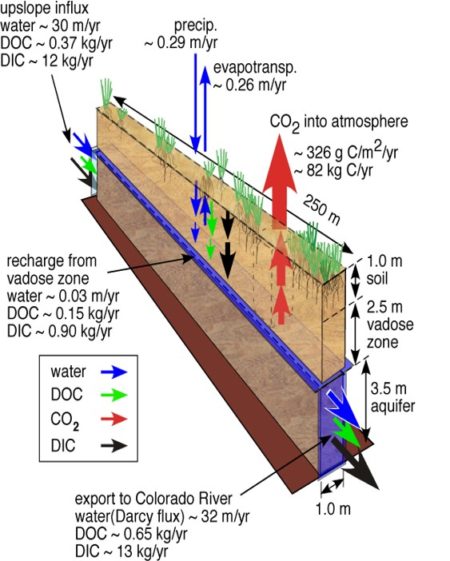
Figure: Estimated carbon fluxes and balance along the measurement transect, showing 30% of annual CO2 emissions from deeper than 1.0 m, contrary to predictions of < 1% by the Earth System Models.
Understanding of terrestrial carbon cycling has relied primarily on studies of top soils that are typically characterized to depths shallower than 0.5 m. We found and quantified 30% of CO2 annual efflux to atmosphere (60% in winter) originates from below 1 m, contrary to prediction of <1% by the ESM land models.
We contend that ESM land models need to incorporate these deeper soil processes to improve CO2 flux predictions in semi-arid climate regions.
Summary
Understanding of terrestrial carbon cycling has relied primarily on studies of topsoils that are typically characterized to depths shallower than 0.5 m. At a semi-arid site, instrumented down to 7 meters, we measured seasonal- and depth-resolved carbon inventories and fluxes, and groundwater and unsaturated zone flow rates. We identified an unexpected high dissolved organic carbon (DOC) flux from the rhizosphere into the underlying unsaturated zone. We measured that ~30% of the CO2 efflux to atmosphere (60% in winter) originates from below 1 m, contrary to prediction of <1% by Earth System Model land models. The seasonal DOC influx and favorable temperatures, moisture and oxygen availability in deeper unsaturated zone sustained the respirations of deeper microbial communities and roots. These conditions are common characteristics of many subsurface environments; thus we contend that ESM land models need to incorporate these deeper soil processes to improve CO2 flux predictions in semi-arid climate regions.
Citation
Wan, J., Tokunaga, T.K., Dong, W., Williams, K.H., Kim, Y., Conrad, M.E., Bill, M., Riley, W.J., Susan S.H., Deep unsaturated zone contributions to carbon cycling in semiarid environments. Journal of Geophysical Research: Biogeosciences, 123. https://doi.org/10.1029/2018JG004669.
